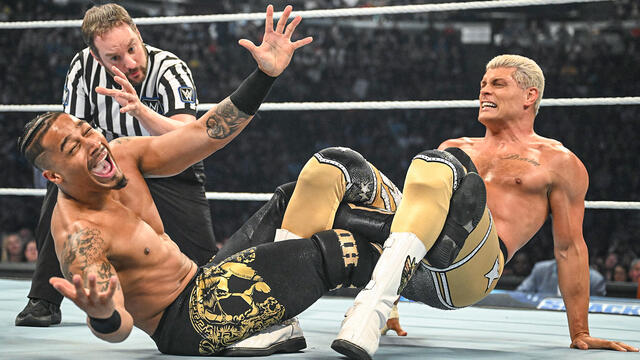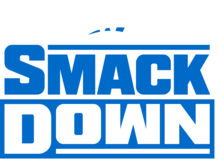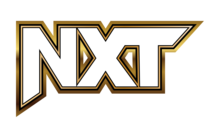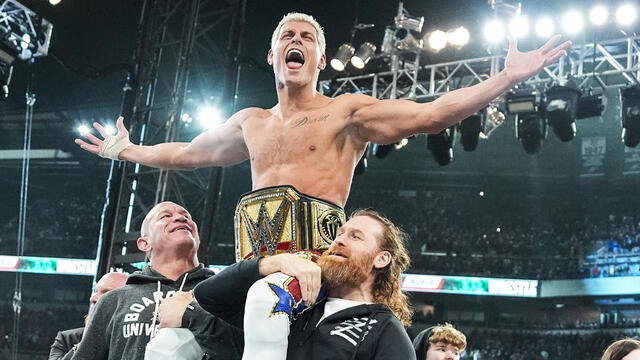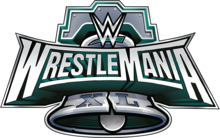25 Moments That Changed WWE History

Just as the flapping of a butterfly's wings can cause a tornado, the smallest actions can spur on seismic shifts in sports-entertainment. As proof, the September 2007 issue of WWE Magazine offers this definitive list of people and events that created today's WWE.
25. A Superstar Is Born
01/23/84
Every era has its stars, the top card talent who pack arenas night after night. Names like Lou Thesz, Bob Backlund and Bruno Sammartino come to mind. But it was the night Hulk Hogan defeated the Iron Sheik in Madison Square Garden that the modern wrestling Superstar was truly born. Overnight, the regional heroes of yesteryear made way for charismatic, larger-than-life national phenoms, as Superstars like the Hulkster, Randy "Macho Man" Savage, Jake "The Snake" Roberts and the Ultimate Warrior invaded the living rooms of millions of families across the country. With Hulkamania unleashed on the world, there was no bottling it back up again.
24. Wrestling Gets Up Off The Mat
In the 1920s, wrestling matches lasted for hours, with the competitors rarely ever getting off the mat. Attendance ultimately bottomed out. Then, from the cornfields of Iowa emerged Toots Mondt, a promoter with a vision for a faster, more exciting style of wrestling. Calling it "Slam Bang Western Style Wrestling," his method showcased flashier moves, like the dropkick and the suplex. Soon, Mondt began booking wrestling feuds, establishing time limits, and exploiting fan favorites and antagonists. He set the foundation for what is the standard in sports-entertainment today.
23. WWE Lays The SmackDown On Primetime
04/29/99
After 300 episodes of Raw, WWE launched its first spinoff show on the fledgling UPN network. With a new stage (the OvalTron) and color scheme (blue), SmackDown became the first weekly primetime sports-entertainment TV series. Going national during the 8-10 p.m. timeslot was a risky proposition considering that Thursday nights were already packed with ratings-dominating sitcoms and WCW Thunder. As it turned out, the popularity of the new WWE series was too much for TNT, which moved its programming to Wednesday nights a mere six months after SmackDown's premiere.
22. "The Body" Moves Into The Governor's Mansion
01/04/99
With his feather boas and earrings, "The Body's" fashion sense was louder than his commentating. But after retiring, Ventura pursued a career in politics, serving as mayor of Brooklyn Park, MN, from 1991 to 1995. In 1998, he won the Minnesota gubernatorial race as an Independent. It was the first time a Superstar had held a major public office—and it showed that wrestlers can be as brainy as they are brawny.
21. The Rock 'N' Wrestling Connection
During the early '80s, WWE tag-teamed with MTV to deliver a one-two combo of music and sports-entertainment that was instrumental in bringing both entities to the masses. Cyndi Lauper and Mr. T began mashing it up on WWE, and Capt. Lou Albano and Roddy Piper were appearing in music videos. Timbaland's "Throw It On Me" video continues the tradition today.
20. The Legend Trainer
There are many wrestlers-turned-trainers who have transformed mere mortals into legends of the ring. However, no one has approached the success of Verne Gagne, the owner, promoter and star of the American Wrestling Association from 1960 to 1991. The list of alumni who've graduated from his esteemed wrestling school reads like a hall of fame induction ceremony: Ric Flair, Curt Hennig, Bob Backlund, Ricky Steamboat, the Iron Sheik, Jimmy Valiant, Sgt. Slaughter and Jimmy Snuka…to name just a few.
19. Freebirds Make An Entrance
In the early 1980s, Michael "P.S." Hayes, Terry "Bam Bam" Gordy, and Buddy "Jack" Roberts formed the Fabulous Freebirds. The trio made its illustrious ring entrance one fateful night to the strains of Lynyrd Skynyrd's "Freebird." The crowd reaction to the song was so powerful that Superstar theme music soon became commonplace, if not compulsory. Without the Freebirds, there'd be no "Sexy Boy."
"I WAS THERE." — Michael "P.S." Hayes
"Terry Gordy would say, ‘Ah hell, Michael, I don't know—mixing music and wrestling?' But I had this idea since I was 15 years old. The people at the wrestling matches were the same people I would see at concerts, and I knew there was a marriage there. Once I convinced Terry, I had to convince the promoters. The first one I tried it on said, ‘They're on those marijuana pills ain't they?' "
18. Piper Opens His Mouth…And The Pit
01/24/84
Accepting that "Rowdy" Roddy Piper's big mouth could not be silenced, WWE put his flapper to good use in the form of the talk show, "Piper's Pit." The segment was responsible for some of sports-entertainment's most infamous moments, from Piper smashing a coconut on Jimmy Snuka's head to his dousing of Morton Downey Jr. with a fire extinguisher. Let's not forget that The Pit also saw Andre the Giant challenge Hulk Hogan for a title match at WrestleMania III, and more recently, The Boogeyman's ingestion of Jillian Hall's mole. Even today, it remains the standard for talk shows within the show. Take notice, Edge.
17. Cruiserweights Take Flight
11/06/94
Brian Pillman won the first-ever Cruiserweight Championship in WCW on 10/27/91. But it was three years later, when WCW joined with AAA, a Mexican wrestling promotion, that high-flying lucha libre wrestling was introduced to American audiences. At the one-shot pay-per-view, When Worlds Collide, the promotions showcased the awesome talents of Eddie Guerrero and Rey Mysterio. It's probably what inspired Paul Heyman to bring Mysterio and Psicosis to ECW, where the duo performed a series of Mexican Death matches. Soon after, WCW breathed new life into their cruiserweight division and the belt that debuted back in '91, is still alive and well on SmackDown today.
16. The Rock Brings The Funny
03/18/00
It used to be that Superstars who appeared in films and on TV shows were typecast as one-dimensional tough guys. Then the People's Champ hosted Saturday Night Live, where he delivered huge ratings and big laughs, and outperformed such wooden athlete-hosts as Derek Jeter, Tom Brady and Wayne Gretzky. As a result, The Rock's acting career shot into the Hollywood A-List stratosphere, and current WWE Superstars are getting the chance to grapple with roles that are a bit meatier than Cyborg No. 2.
15. Wrestling Gets Cagey
07/02/37
Back in the day, Houston promoter Paul Boesch proposed a unique way for Jack Bloomfield and Count Petro Rossi to settle their feud—surround the ring with chicken wire to keep them in and others out. It worked, becoming the first official cage match in wrestling history. Alternate versions of the cage were created, but it wasn't until the late '60s that Freddie Blassie and promoter Mike LeBell added the stipulation for a wrestler to climb over the top or walk through the door.
14. New Champions Break Barriers
02/08/71, 08/02/92
Ron Simmons and Pedro Morales are the Jackie Robinson and Roberto Clemente of sports-entertainment, having broken records and racial barriers as the first African-American and Latino World Champions, respectively. Morales won the WWE Championship in 1971, and Simmons snagged the WCW title in 1992. That's correct: they're the guys whom Eddie Guerrero, Rey Mysterio, King Booker, Bobby Lashley, The Rock, and all fans, have to thank for WWE's incredible diversity today.
"I WAS THERE." — Ron Simmons
"Winning the title was a surprise to me. I was scheduled to be in the second or third match on the card, but my name was thrown in a sack for a raffle to determine the number one contender against Vader. My name was drawn, and I won—and that's how it really took place. Even today I'm still in awe of it. I love being the example because it opened the doors for others. I would also like to think that not only blacks, but people of any color would be proud of me and how I carried myself throughout my career."
13. The Horsemen Build A Stable
01/86
In 1986, Ric Flair, Tully Blanchard, Arn and Ole Anderson, along with their manager, James J. Dillon, founded what's possibly the most influential faction in sports-entertainment history. The Four Horsemen worked as a cohesive unit; where one Horseman rode, the others followed, often leaving carnage in their wakes. Through the years, members would come and go, and yet entrance into this elite club almost always guaranteed Superstardom. Brian Pillman, Dean Malenko, Sid Vicious, and Barry Windham, all found success as Horsemen. Without the formation of this stable of studs, there would be no D-Generation X, nWo, Evolution or the New Breed. Unthinkable.
12. The King vs. The Comedian
04/05/82
Funnyman Andy Kaufman, best known for his role on Taxi, made waves when he became an "Intergender" champion in Memphis Wrestling by issuing challenges to women. This didn't sit well with Jerry Lawler, who confronted the comedian on Late Night with David Letterman; Lawler slapped Kaufman and Kaufman retaliated by throwing coffee on Lawler. The exchange remains among the most shocking in TV history. The rivals eventually exchanged blows inside a ring. Before this encounter, celebs rarely set foot near the ring. Since then, WWE has played host to the likes of Donald Trump, Arnold Schwarzenegger, Steve-O and, uh, K-Fed.
"I WAS THERE." — Jerry Lawler
"Me hitting Andy on Letterman was the first time that wrestling got that much national mainstream coverage. Even The New York Times was on it. It's a top 100 moment in the history of television according to the National Museum of Television and Radio. At that time, we fiercely guarded the secrecy of our business, but when it got the mainstream publicity that it did—then you saw the likes of Cyndi Lauper and Mr. T in WWE. I think it set the stage for outside involvement in the business. None of it could have happened without Andy."
11. The End Of The War
03/26/01
WCW fans who tuned into their regularly scheduled programming on March 26, 2001, were treated to the impossible: a smug Mr. McMahon's announcing the final broadcast of Nitro. The show was simulcast with Raw, and by the end of the evening, the Monday Night War was officially over. The WWE rosters surged with an infusion of new talent that included Rey Mysterio, King Booker, Gregory Helms, Chavo Guerrero and Torrie Wilson.
"I WAS THERE." — King Booker
"When the nWo came on, it made Vince McMahon look to another strategy. He played with a good strategy and it worked out for him, but I think it made everybody step up the bar and think a little bit differently about the business. WCW gave me the chance of being the Champion and having the people buying into Booker T in that role. If WCW never folded, I would have probably retired in WCW because I did a whole lot for them and the company was always very loyal to me."
10. Marian Roussimoff Gives Birth To A Giant
05/19/46
Raised in Grenoble, France, Andre Rene Roussimoff was born with acromegaly, a disease more commonly known as Gigantism caused by excess growth hormone secretion in the body. During his lifetime, Andre would go by many names, including Monster Roussimoff and The Butcher. But it was in the early 1970s, after a meeting with Vince McMahon Sr., that he earned the moniker "Giant." At 7'4" and 500 pounds, Andre remains wrestling's most memorable big man ever, famously main-eventing WrestleMania III against Hulk Hogan, co-starring in such films as The Princess Bride, and creating invaluable fan-interest in sports-entertainment.
9. A Night In Montréal Awakens The Devil
11/09/97
The Montréal Screwjob is perhaps the most shocking match in sports-entertainment history. Shawn Michaels walked away as the new champ. Bret Hart left town for WCW. And Vince McMahon infamously called for the bell while Hart was locked in the Sharpshooter. On Raw, following the Montréal incident, Mr. McMahon uttered the unforgettable phrase, "Bret screwed Bret." The instant those words left his lips, The Chairman was born.
8. Let the Bodies Hit The Floor
08/27/94
When Shane Douglas became the new NWA Champion of Eastern Championship Wrestling, he stunned the world by throwing the title on the floor in disgust—an act that marked the death of Eastern Championship Wrestling and the rise of Extreme Championship Wrestling. With Paul Heyman at the helm, ECW instituted hardcore rules, and the liberal use of chairs, tables and barbwire. The promotion attracted a unique breed of wrestling diehard, forcing WCW and WWE to respond to the challenge by creating their own Hardcore Championships. Although the style was imitated, it's fair to say that it was never duplicated.
7. Breaking Away From The NWA
01/24/63
During the late '50s and early '60s, there was only one World Champion, and he hailed from the National Wrestling Alliance. But as territories grew in size and popularity, promotions began breaking away from the NWA to fashion their own identities. By 1963, WWE (then known as the World Wide Wrestling Federation) was formed. It wasn't long before WWE emerged as the number-one wrestling promotion in the northeast, laying the foundation for future generations of Superstars.
6. WCW Fires The Future
11/94
While sitting out with an injury, Steve Austin was fired by WCW brass…via a phone call! An angry Austin joined ECW and verbally lashed out at his former employer through interview segments and scathing Eric Bischoff impersonations. Austin then entered WWE, quickly shedding the "The Ringmaster" image to become the beer-guzzling, middle-finger-saluting bionic redneck we know and love. The phrase "Austin 3:16 says I've just whipped your ass!" helped launch the "Attitude Era," which was nothing short of a renaissance in sports-entertainment. And all because one man was overlooked and let go.
5. A Man Named George Turns Gorgeous
George Wagner began wrestling in the 1940s, but initially, he had little success standing out. So while working in the AWA, Wagner reinvented himself…as Gorgeous George. He grew out his hair, dyed it platinum blond and pinned it with gold-plated bobby pins; he wore elaborate robes to the ring, and dubbed himself "The Human Orchid," making his entrances alongside a butler who would spray opponents with perfume or disinfectant. George's over-the-top persona and effeminate behavior drove fans into a frenzy, and succeeded in making him the biggest wrestling icon at the dawn of the TV Age. His legacy lives on, as his larger-than-life blueprint is the basis for many Superstar identities, from Flair to Hogan to The Rock. But not Steve Blackman.
4. Monday Nights Get Raw
01/11/93
When Raw debuted at the Manhattan Center in New York City, fans were shocked to see Superstars take on other Superstars, an occurrence once reserved for pay-per-views. From that night onward, the frenetic program would be responsible for some of the most memorable and entertaining moments in WWE history, including Mankind's "This Is Your Life" segment, Stone Cold's confrontation with Mike Tyson, The Rock's challenge to Hogan and DX's invasion of Nitro. The show single-handedly reinvented Monday night television, making the workweek something actually worth looking forward to.
"I WAS THERE."— Jim Ross
"I think the impact Raw has had on the business is comparable to Monday Night Football. For generations, televised wrestling was on the weekends. So when Raw moved to prime time, it was much akin to the NFL moving weekend football programming to Monday night. Raw really underscored that Monday night is wrestling night in this country, just like the early days of football laid claim to Sunday as football day."
3. Pay-Per-View Mania
10/31/85
From the get-go, WrestleMania grabbed headlines as well as fans' imaginations by recruiting such celebrities as Muhammad Ali to appear beside Superstars. With 'Mania's smash success, WWE began producing other PPVs. By 1988, fans were treated to four annual PPVs each calendar year; it was like having a Super Bowl Sunday every single season!
"I WAS THERE."— Howard Finkel
"When we were trying to find a name for the big event, I blurted out that I had an idea…when The Beatles hit America there was a craze called BeatleMania. A new craze is going to be born in 1985…let's call it WrestleMania."
2. WCW Dominates
In the span of two years, WCW emerged as one of the largest wrestling companies on the planet. It started with the acquisition of Hulk Hogan in 1994, followed by the launch of a weekly wrestling program in 1995, which competed in the same time slot as Raw. Soon afterward, the sports-entertainment world was turned on its ear when Scott Hall formally appeared on Nitro stating, "We are taking over." From there, the nWo's popularity grew exponentially, propelling WCW into a ratings juggernaut. But the bigger they are…the harder their ratings fall. In 2001, WCW went bye-bye.
1. Vince Takes Wrestling National
Vince McMahon joined the family business in 1972, teaming with his father to run Capital Wrestling Corporation. In 1982, Vince purchased CWC from his father, and renamed it. In the process, The Chairman signed every major star from competing territories, recruiting the likes of Hulk Hogan (from the AWA) and Roddy Piper (from Mid-Atlantic Wrestling). From there, the regional biz transformed into a national phenomenon, and then into an international powerhouse. Today, millions of people around the globe tune into WWE programming. In the U.S. alone, WWE reaches approximately 16 million during an average week, making its programs some of the most watched on TV.
The above article can also be found in the September edition of WWE Magazine. Pick up your copy on newsstands today.Or subscribe to WWE Magazine.
WWE Shows Latest Results
Raw results, April 29, 2024: Jey Uso clinches massive win in Six-Man Tag Team Match prior to title bout with Damian Priest
Full ResultsNXT Spring Breakin' 2024 Week Two results: Lola Vice knocks out Natalya in first-ever Women's NXT Underground Match
Full Results





